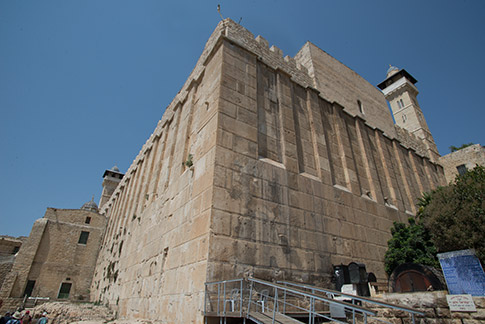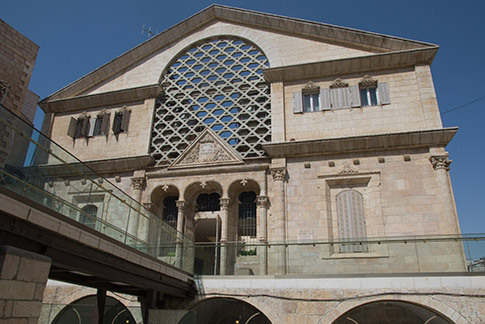The return to the promised land has had a massive impact on the Jewish people. Reconnecting to their ancient land and language has helped to develop a Bible centred culture. It often seems that wherever one digs into the soil of the holy land, it becomes an archaeological site! One example of this phenomena, of the land of Israel bringing us to the Bible, appeared on the Israel HaYom news site recently, with the headline, "Secrets of the Cave of the Patriarchs exposed.” The introduction to the article, by Nadav Shragai reads, "Noam Arnon's comprehensive doctoral dissertation on the Cave of the Patriarchs proves there is much more to the ancient site than meets the eye.”
The land of Israel and the city of Hebron, inevitably bring you to the burying place of the patriarchs, and in particular to the patriarch Abraham. In connecting to Abraham, one cannot avoid hearing his calling by God, to leave Ur of the Chaldees and to then follow his journey of faith to the land of promise. Naturally the question arises of when the promises of God to him will be fulfilled — when will Abraham inherit the land? This raises the inescapable question of when he will be raised from the dead. Indeed, the land of Israel brings you to the gospel — the good news of the restoration again of the kingdom to Israel.

The Herodian structure, built over the cave of Machpelah about 2000 years ago.
Abraham, Sarah, Isaac, Rebekah, Jacob and Leah are all buried in the caves under the structure.
Photo: David Billington
As the article points out, Noam Arnon has an, "intimate knowledge of the site, which he has lived, breathed, and researched for almost five decades.” Noam is a resident of Beit Hadassah in the heart of Hebron. Beit Hadassah was built in 1893 with the contributions of North African Jews and housed a medical clinic, providing free medical care for both Jews and Arabs. The Jewish community in Hebron was destroyed in 1929 by Arab riots and the clinic was destroyed. After 1967 with heroic struggles and tragedy, Jews returned to Hebron and eventually Beit Hadassah was made into apartments. We had the privilege of having a visit with David Wilder there about 3 years ago. There are bullet holes in his apartment wall from an Arab sniper. Even today living in Hebron requires a measure of faith. Residing in the heart of Hebron a short walk from the Cave of the Patriarchs, has given Noam Arnon unique opportunities and a valuable perspective of the site. Over the last eight years Dr. Noam Arnon has written a 600-page doctoral thesis on the site, completed at the Department of Land of Israel Studies and Archaeology at Bar Ilan University. Part of the thesis records both documented and secret visits which have taken place to the caves below the current building, which was constructed about 2000 years ago by Herod the Great.

Beit Hadassah, Hebron, the home of Dr. Noam Arnon - just a short walk from the cave
of Machpelah.
Photo: David Billington
Genesis 23:9 and 25:9 record the name of the cave of the patriarchs as “the cave of Machpelah”. This is what the cave is called today in Israel, “Maraat Ha’Machpelah”. Gesenius' lexicon says the word Machpelah means “a doubling”, “portion, part, lot”. The cave under the structure is said to be a double cave, so this meaning fits well.
However, Genesis 49:30 and other passages describe the cave as “the cave that is in the field of Machpelah”. Again, Gesenius' lexicon says the word Machpelah means “a doubling”, “portion, part, lot”. The word field, “sedae” does mean a field, but it has a wider usage and also refers to a "definite portion of ground” whether cultivated or not. This phrase from Genesis then could be translated as, “the cave that is in the double portion of ground”. From Deuteronomy 21:17, we understand that according to the law of Moses, the firstborn was allotted a double portion of the inheritance. It is fascinating that those buried in the cave of Machpelah - Abraham, Issac and Jacob (by transaction) are firstborns, and therefore entitled to a double portion. These giants of faith should be an inspiration to all of us, who seek the promises of God.
On a secret visit into the caves in 1981, some earthenware pieces were retrieved. Dr. Zeev Yavin, the chief archaeology officer for Judea and Samaria identified them as being from the first temple period. The article says that,
"It was only recently, some 40 years after that adventure, that a scientific analysis was conducted by Prof. David Ben Shlomo, head of the Land of Israel Studies and Archeology Department at Ariel University, and Prof. Hans Mommsen of the University of Bonn, a leading expert on identifying pottery through compositional analysis.
"The analysis found that the items of pottery that were brought to the cave from various sites around Israel - the Hebron Hills, Jerusalem, and the Shfela (Judean Foothills) - by people who lived in these areas and had gone to the cave. This shows us that most likely the cave was a pilgrimage site during First Temple times.”
The Bible actually records a visit to Hebron from the Shfela, by one of the renowned judges of Israel - Samson. Judges 16:1-3 records:
"Then went Samson to Gaza, and saw there an harlot, and went in unto her. And it was told the Gazites, saying, Samson is come hither. And they compassed him in, and laid wait for him all night in the gate of the city, and were quiet all the night, saying, In the morning, when it is day, we shall kill him. And Samson lay till midnight, and arose at midnight, and took the doors of the gate of the city, and the two posts, and went away with them, bar and all, and put them upon his shoulders, and carried them up to the top of an hill that is before Hebron.”
Samson no doubt, had the promise to Abraham — "thy seed shall possess the gate of his enemies" on his mind, as he carried the gates of Gaza on his shoulders, from the Shfela to before Hebron, an uphill journey of about 55 kilometres. What a journey of faith and a graphic witness and inspiration to the people of Judah, that everything is possible when God is on our side!
Abraham, Sarah, Issac, Rebekah, Jacob and Leah are all buried in the cave of the Patriarchs. Hebrews 11:13 summarizes all of them in saying,
"These all died in faith, not having received the promises, but having seen them afar off, and were persuaded of them, and embraced them, and confessed that they were strangers and pilgrims on the earth.”
They were all visionaries, who through the eye of faith saw the reality of the promises and fell in love with them. They looked for God’s coming kingdom, the kingdom of heaven in the land promised to Abraham - the kingdom of God in the land of Israel.
Starting with Abraham there have been many journeys of faith to the land of promise. Each of us understands that if we wish to be associated with Abraham, we too must make a journey of faith. The Lord Jesus Christ made the greatest journey of faith, no doubt with the promises on his mind and the stake upon his shoulder to Golgotha. It was a journey of victory over the flesh. Like Samson he led “captivity captive”, taking the bars and gates of sin, of repression and of servitude and bringing them captive to the place of the promises.
Thanks for listening. Come back next week God willing to www.bibleinthenews.com. This has been David Billington with you.
The full article about the discoveries at Maraat Ha’Machpelah can be found here: https://www.israelhayom.com/2021/11/02/the-secrets-of-the-cave-of-the-patriarchs/